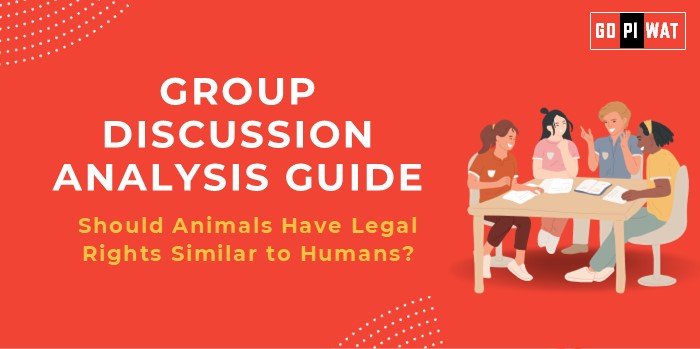📋 Group Discussion (GD) Analysis Guide: Should Animals Have Legal Rights Similar to Humans?
🌐 Introduction to the Topic
- 🔍 Opening Context: “Do animals deserve the same legal rights as humans? This provocative question challenges our ethical frameworks, touching upon animal welfare, environmental sustainability, and humanity’s role in nature.”
- 📖 Topic Background: The concept of legal rights for animals originates from discussions on moral philosophy, animal rights movements, and landmark cases worldwide. With growing concerns about species extinction and cruelty, this topic has gained prominence, influencing international policies and individual ethical decisions.
📊 Quick Facts and Key Statistics
– 🐾 Global Animal Cruelty Reports: Over 70 billion land animals are slaughtered annually for food, often in inhumane conditions (FAO).
– ⚖️ Legal Precedents: Ecuador’s constitution grants rights to nature, including animals.
– 🌍 Biodiversity Crisis: Over 1 million species face extinction due to human activities (UN).
– 🌎 Public Sentiment: Surveys show 67% of people globally support stronger animal protection laws (Ipsos, 2023).
– ⚖️ Legal Precedents: Ecuador’s constitution grants rights to nature, including animals.
– 🌍 Biodiversity Crisis: Over 1 million species face extinction due to human activities (UN).
– 🌎 Public Sentiment: Surveys show 67% of people globally support stronger animal protection laws (Ipsos, 2023).
🤝 Stakeholders and Their Roles
- 🏛️ Governments: Enact and enforce animal protection laws, regulate industries.
- 📢 NGOs and Activists: Advocate for rights, raise awareness, and rescue animals.
- 🏢 Businesses: Balancing ethical practices in industries like farming, research, and entertainment.
- 👥 Consumers: Driving demand for ethical products and animal-friendly policies.
🏆 Achievements and Challenges
✨ Achievements:
- ⚖️ Legal Rights: India’s 2014 Supreme Court ruling recognized animals as “living beings with rights.”
- 🐅 Conservation Efforts: Increased tiger populations in India and global bans on animal testing for cosmetics.
- 📢 Awareness Campaigns: Initiatives like “Adopt, Don’t Shop” reduce unethical breeding practices.
⚠️ Challenges:
- 🛑 Enforceability: Difficulty in enforcing animal rights due to cultural and economic factors.
- 💸 Economic Trade-offs: Livelihoods in industries such as meat production.
- 🌍 Global Inequality: Limited resources in developing nations for implementing animal welfare measures.
🌍 Global Comparisons:
– New Zealand: Recognized legal personhood for a river (Whanganui River) to safeguard ecosystems.
– European Union: Banned animal testing for cosmetics but struggles with illegal practices.
📌 Case Studies:
– India: Jallikattu debates highlight conflicts between cultural traditions and animal rights.
– Kenya: Anti-poaching laws helped recover elephant populations.
🧠 Structured Arguments for Discussion
- ✅ Supporting Stance: “Recognizing animal rights ensures ethical treatment, prevents cruelty, and supports biodiversity preservation.”
- ❌ Opposing Stance: “Extending human-like rights to animals disrupts economic systems and conflicts with cultural practices.”
- ⚖️ Balanced Perspective: “While granting animals legal rights may seem idealistic, a phased approach addressing ethical, economic, and cultural concerns is pragmatic.”
🎯 Effective Discussion Approaches
- 📜 Opening Approaches:
- 🤔 Ethical Argument: “If animals feel pain and emotions, shouldn’t they have the right to live free from cruelty?”
- 🔬 Scientific Viewpoint: “With studies confirming animal sentience, denying them rights becomes increasingly difficult to justify.”
- 🔍 Counter-Argument Handling:
- Economic Concern: “Phased transitions and alternative livelihoods can address industry impacts.”
- Cultural Traditions: “Respect for traditions should be balanced with humane practices.”
🔍 Strategic Analysis of Strengths and Weaknesses
- 💪 Strengths: Advances in science affirm animal sentience; growing public support.
- ⚠️ Weaknesses: Lack of universal definitions and enforceability.
- 🚀 Opportunities: Ethical consumerism, international cooperation.
- ⚡ Threats: Resistance from industries, cultural conflicts.
🎓 Connecting with B-School Applications
- 🌟 Real-World Applications: Exploring corporate social responsibility in industries like food production; analyzing consumer behavior towards ethical products.
- ❓ Sample Interview Questions:
- “What economic implications arise from granting animals legal rights?”
- “How can businesses adapt to stricter animal welfare regulations?”
- 💡 Insights for B-School Students:
- The importance of ethical decision-making.
- Recognizing the link between environmental, economic, and ethical issues.


